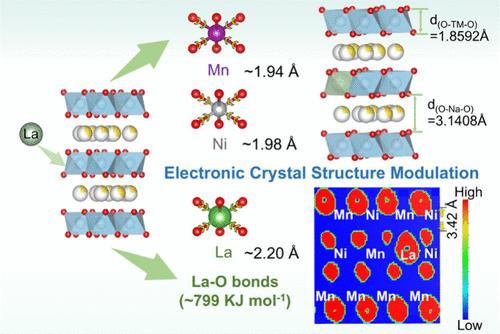Chemically Anchored Lattice Oxygen Enables Stability in Layered Sodium Cathodes
IF 18.2
1区 材料科学
Q1 CHEMISTRY, PHYSICAL
引用次数: 0
Abstract
The long-term performance of P2-type layered transition metal oxides is often compromised by irreversible oxygen redox and lattice instability, resulting in rapid capacity degradation. This work proposes a dual-site La3+ substitution strategy to stabilize the lattice oxygen and improve the electrochemical durability. The substitution of La3+ into the transition metal layer forms strong La─O covalent interactions that anchor lattice oxygen while simultaneously lowering the O 2p orbital energy to suppress parasitic oxygen evolution. This electronic and structural modulation enables controlled anionic redox behavior and enhances phase reversibility under deep charge. In situ XRD reveals a minimal volume change (0.9%) during cycling, indicative of an apparent structural resilience. The optimized 0.02La-doped cathode exhibits stable full-cell performance when paired with commercial hard carbon, achieving 80.2% capacity retention over 600 cycles at 5C. These findings demonstrate a viable path toward stable sodium-ion cathodes via rare-earth-assisted lattice oxygen regulation.

化学锚定晶格氧使层状钠阴极稳定
p2型层状过渡金属氧化物的长期性能经常受到不可逆氧氧化还原和晶格不稳定性的影响,导致容量快速退化。本工作提出了一种双位置La3+取代策略来稳定晶格氧并提高电化学耐久性。La3+在过渡金属层中的取代形成了强的La─O共价相互作用,锚定了晶格氧,同时降低了o2p轨道能量,抑制了寄生氧的演化。这种电子和结构调制可以控制阴离子氧化还原行为,并增强深电荷下的相可逆性。原位XRD显示,在循环过程中,体积变化最小(0.9%),表明具有明显的结构弹性。当与商用硬碳配对时,优化后的0.02 la掺杂阴极具有稳定的全电池性能,在5C下600次循环中保持80.2%的容量。这些发现证明了通过稀土辅助的晶格氧调控制备稳定钠离子阴极的可行途径。
本文章由计算机程序翻译,如有差异,请以英文原文为准。
求助全文
约1分钟内获得全文
求助全文
来源期刊

ACS Energy Letters
Energy-Renewable Energy, Sustainability and the Environment
CiteScore
31.20
自引率
5.00%
发文量
469
审稿时长
1 months
期刊介绍:
ACS Energy Letters is a monthly journal that publishes papers reporting new scientific advances in energy research. The journal focuses on topics that are of interest to scientists working in the fundamental and applied sciences. Rapid publication is a central criterion for acceptance, and the journal is known for its quick publication times, with an average of 4-6 weeks from submission to web publication in As Soon As Publishable format.
ACS Energy Letters is ranked as the number one journal in the Web of Science Electrochemistry category. It also ranks within the top 10 journals for Physical Chemistry, Energy & Fuels, and Nanoscience & Nanotechnology.
The journal offers several types of articles, including Letters, Energy Express, Perspectives, Reviews, Editorials, Viewpoints and Energy Focus. Additionally, authors have the option to submit videos that summarize or support the information presented in a Perspective or Review article, which can be highlighted on the journal's website. ACS Energy Letters is abstracted and indexed in Chemical Abstracts Service/SciFinder, EBSCO-summon, PubMed, Web of Science, Scopus and Portico.
 求助内容:
求助内容: 应助结果提醒方式:
应助结果提醒方式:


